1996 CHEVROLET ASTRO mirror
[x] Cancel search: mirrorPage 98 of 372
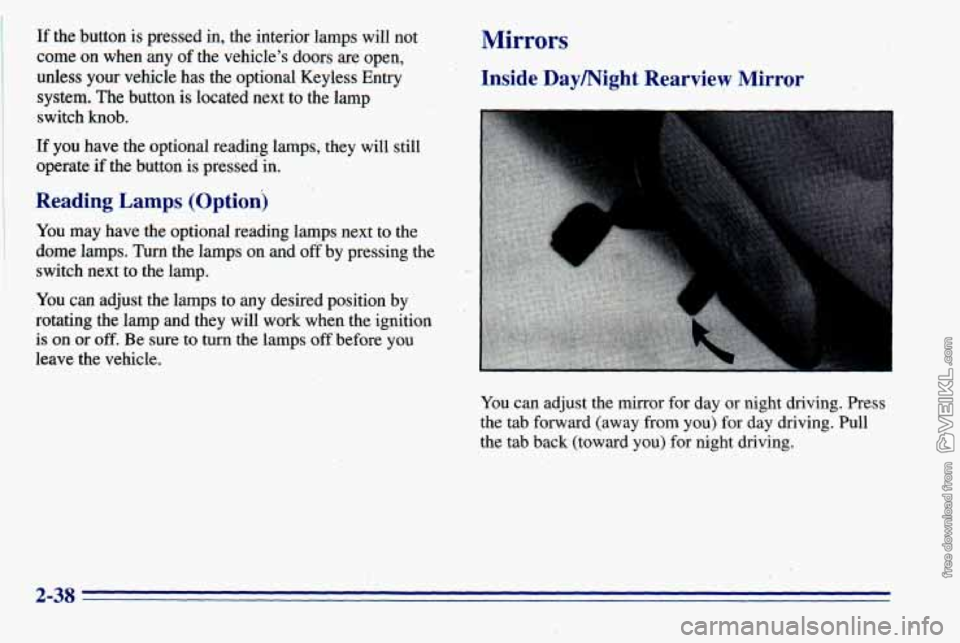
If the button is pressed in, the interior lamps will not
come on when any
of the vehicle’s doors are open,
unless your vehicle has the optional Keyless Entry
system. The button
is located next to the lamp
switch knob.
If you have the optional reading lamps, they will still
operate if the button
is pressed-in.
Reading Lamps.(Option)
You may have the optional reading lamps next to the
dome lamps. Turn the lamps on and
off by pressing the
switch next
to the lamp.
You can adjust the lamps to any desired position by
rotating the ,lamp and they will work when the ignition
is on or off. Be sure to turn the lamps off before you
leave the vehicle.
.- , , ,,
Mirrors
Inside Daymight Rearview Mirror
You can adjust the mirror for day or night driving. Press
the tab forward ‘(away from
you) for day driving. Pull
the tab back (toward
you) for night driving.
2-38
Page 99 of 372
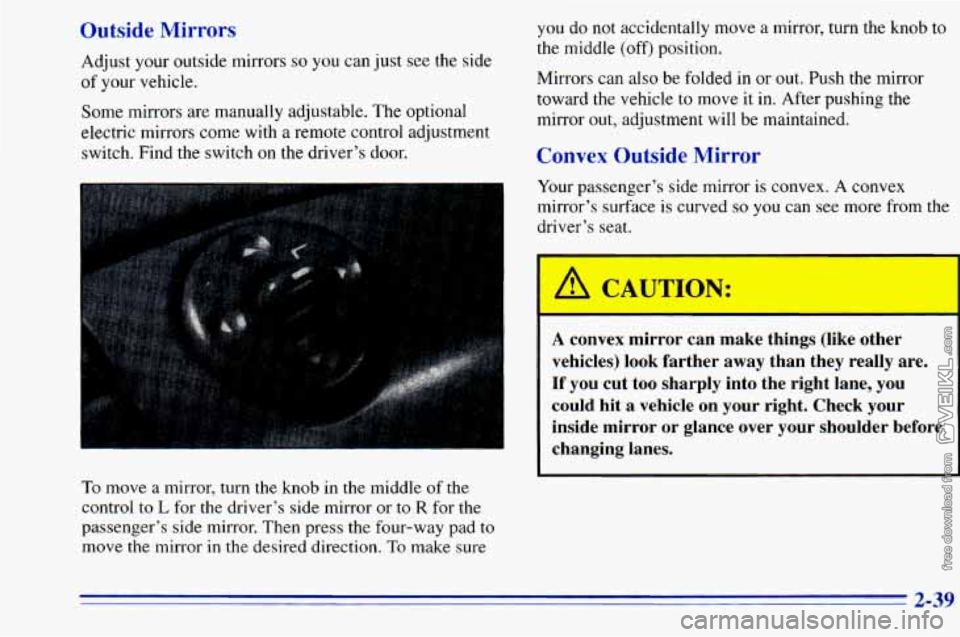
Outside Mirrors
Adjust your outside mirrors so you can just see the side
of your vehicle.
Some mirrors are manually adjustable. The optional
electric mirrors come with a remote control adjustment
switch. Find the switch on the driver’s door. you
do not accidentally move a mirror, turn the knob to
the middle (off‘) position.
Mirrors can also be folded in
or out. Push the mirror
toward the vehicle to move it in. After pushing the
mirror out, adjustment will be maintained.
Convex Outside Mirror
Your passenger’s side mirror is convex. A convex
mirror’s surface
is curved so you can see more from the
driver’s seat.
To move a mirror, turn the knob in the middle of the
control
to L for the driver’s side mirror or to R for the
passenger’s side mirror. Then press the four-way pad to
move the mirror in
the desired direction. To make sure
A convex mirror can make things (likl- Aher
vehicles) look farther away than they really are.
If you cut too sharply into the right lane, you
could hit
a vehicle on your right. Check your
inside mirror or glance over your shoulder before
changing lanes.
2-39
Page 109 of 372
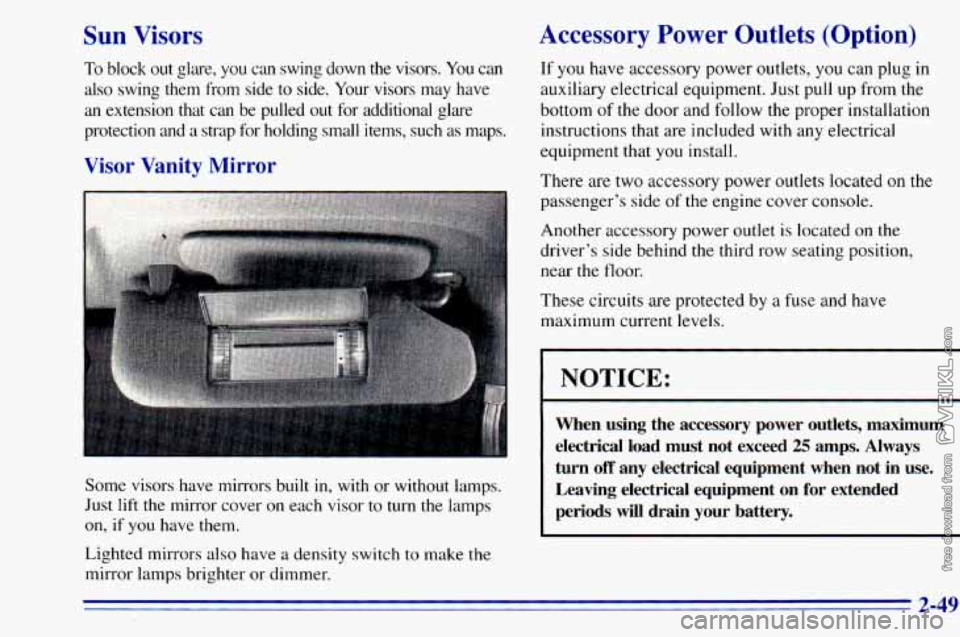
Sun Visors
To block out glare, you can swing down the visors. You can
also swing them from side
to side. Your visors may have
an extension that can be pulled
out for additional glare
protection and
a strap for holding small items, such as maps.
Visor Vanity Mirror
I-
Some visors have mirrors built in, with or without lamps.
Just
lift the mirror cover on each visor to turn the lamps
on, if you have them.
Lighted mirrors also have a density switch to make
the
mirror lamps brighter or dimmer.
Accessory Power Outlets (Option)
If you have accessory power outlets, you can plug in
auxiliary electrical equipment. Just pull up from the
bottom
of the door and follow the proper installation
instructions that are included with any electrical
equipment that
you install.
There are two accessory power outlets located on the
passenger’s side
of the engine cover console.
Another accessory power outlet is located on the
driver’s side behind
the third row seating position,
near the floor.
These circuits are protected by
a fuse and have
maximum current levels.
I NOTICE:
~~
When using the accessory power outlets, maximum
electrical load must not exceed
25 amps. Always
turn
off any electrical equipment when not in use.
Leaving electrical equipment
on for extended
periods will drain your battery.
2-49
Page 165 of 372
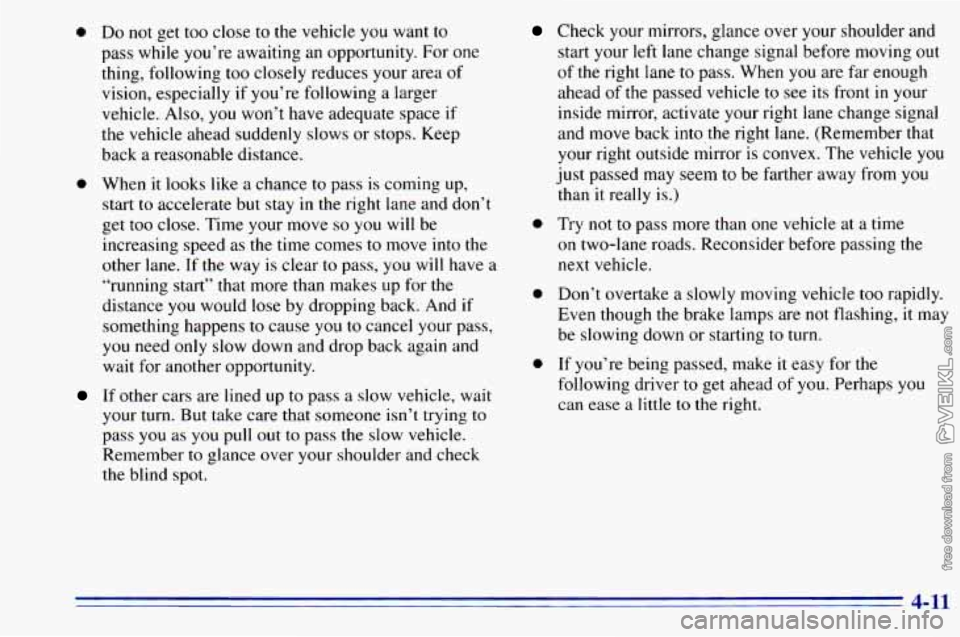
0 Do not get too close to the vehicle you want to
pass while you’re awaiting an opportunity. For one
thing, following
too closely reduces your area of
vision, especially if you’re following a larger
vehicle. Also,
you won’t have adequate space if
the vehicle ahead suddenly slows or stops. Keep
back a reasonable distance.
0 When it looks like a chance to pass is coming up,
start to accelerate but stay
in the right lane and don’t
get too close. Time your move
so you will be
increasing speed as
the time comes to move into the
other lane. If the way is clear to pass, you will have a
“running start” that more than makes up for
the
distance you would lose by dropping back. And if
something happens
to cause you to cancel your pass,
you need
only slow down and drop back again and
wait for another opportunity.
If other cars are lined up to pass a slow vehicle, wait
your turn. But take care that someone
isn’t trying to
pass you as you pull out to pass the slow vehicle.
Remember
to glance over your shoulder and check
the blind spot.
Check your mirrors, glance over your shoulder and
start your left lane change signal before moving out
of the right lane to pass. When you are far enough
ahead
of the passed vehicle to see its front in your
inside mirror, activate your right lane change signal
and move back
into,the right lane. (Remember that
your right outside mirror is convex. The vehicle you
just passed may seem to be farther away from
you
than it really is.)
0 Try not to pass more than one vehicle at a time
on two-lane roads. Reconsider before passing the
next vehicle.
0 Don’t overtake a slowly moving vehicle too rapidly.
Even though
the brake lamps are not flashing, it may
be slowing down or starting to turn.
0 If you’re being passed, make it easy for the
following driver to get ahead of you. Perhaps you
can ease a little to the right.
4-11
Page 166 of 372
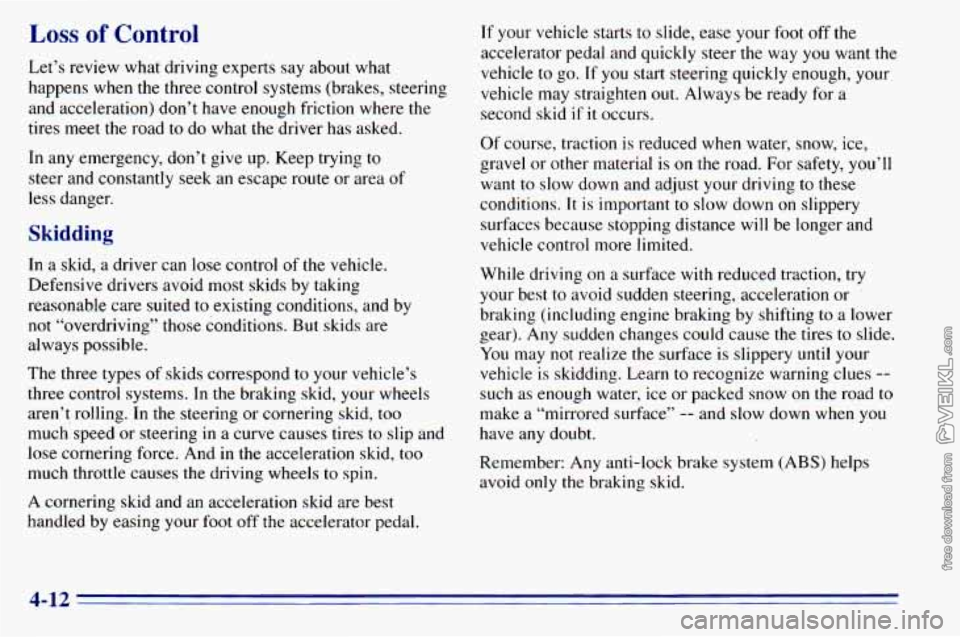
Loss of Control
Let’s review what driving experts say about what
happens when the three control systems (brakes, steering
and acceleration) don’t have enough friction where the
tires meet the road
to do what the driver has asked.
In
any emergency, don’t give up. Keep trying to
steer and constantly seek an escape route or area of
less danger.
Skidding
In a skid, a driver can lose control of the vehicle.
Defensive drivers avoid most skids by taking
reasonable care suited to existing conditions, and by
not “overdriving” those conditions. But skids are
always possible.
The three types
of skids correspond to your vehicle’s
three control systems. In the braking skid, your wheels
aren’t rolling. In
the steering or cornering skid, too
muchspeed or steering
in a curve causes tires to slip and
lose cornering force. And in the acceleration skid, too
much throttle causes the driving wheels
to spin.
A cornering skid and an acceleration skid are best
handled by easing your foot off the accelerator pedal.
If your vehicle starts to slide, ease your foot off the
accelerator pedal and quickly steer the way
you want the
vehicle
to go. If you start steering quickly enough, your
vehicle may straighten out. Always be ready for a
second skid
if it occurs.
Of course, traction is reduced when water, snow, ice,
gravel or other material is on the road. For safety,
you’ll
want to slow down and adjust your driving to these
conditions. It is important to slow down
on slippery
surfaces because stopping distance will be longer and
vehicle control more limited.
While driving on a surface with reduced traction, try
your best to avoid sudden steering, acceleration or
braking (including engine braking by shifting
to a lower
gear).
Any sudden changes could cause the tires to slide.
You may not realize the surface is slippery until your
vehicle is skidding. Learn to recognize warning clues
--
such as enough water, ice or packed snow on the road to
make a “mirrored surface”
-- and slow down when you
have any doubt.
Remember: Any anti-lock brake system (ABS) helps
avoid only
the braking skid.
4-12
Page 167 of 372
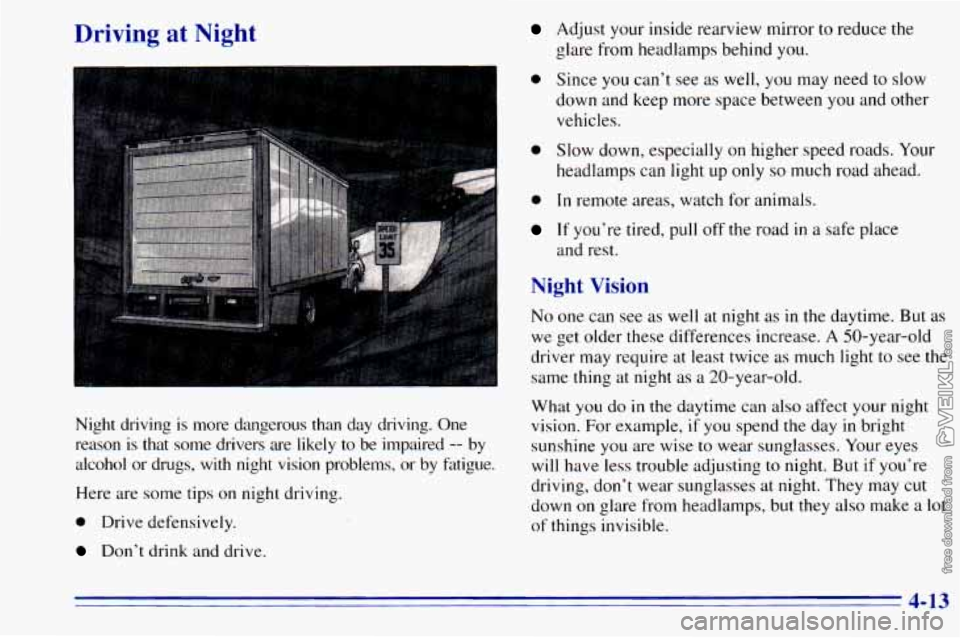
Driving at Night
Night driving is more dangerous than day driving. One
reason
is that some drivers are likely to be impaired -- by
alcohol
or drugs, with night vision problems, or by fatigue.
Here are some tips on night driving.
0 Drive defensively.
Don’t drink and drive.
Adjust your inside rearview mirror to reduce the
glare from headlamps behind you.
0 Since you can’t see as well, you may need to slow
down and keep more space between you and other
vehicles.
0 Slow down, especially on higher speed roads. Your
headlamps
can light up only so much road ahead.
0 In remote areas, watch for animals.
If you’re tired, pull off the road in a safe place
and rest.
Night Vision
No one can see as well at night as in the daytime. But as
we get older these differences increase. A 50-year-old
driver may require at least twice
as much light to see the
same thing at night
as a 20-year-old.
What you do
in the daytime can also affect your night
vision. For example,
if you spend the day in bright
sunshine you are wise to wear sunglasses. Your eyes
will have less trouble adjusting to night. But
if you’re
driving, don’t wear sunglasses at night. They may cut
down on glare from headlamps, but they also make a lot
of things invisible.
4-13
Page 172 of 372
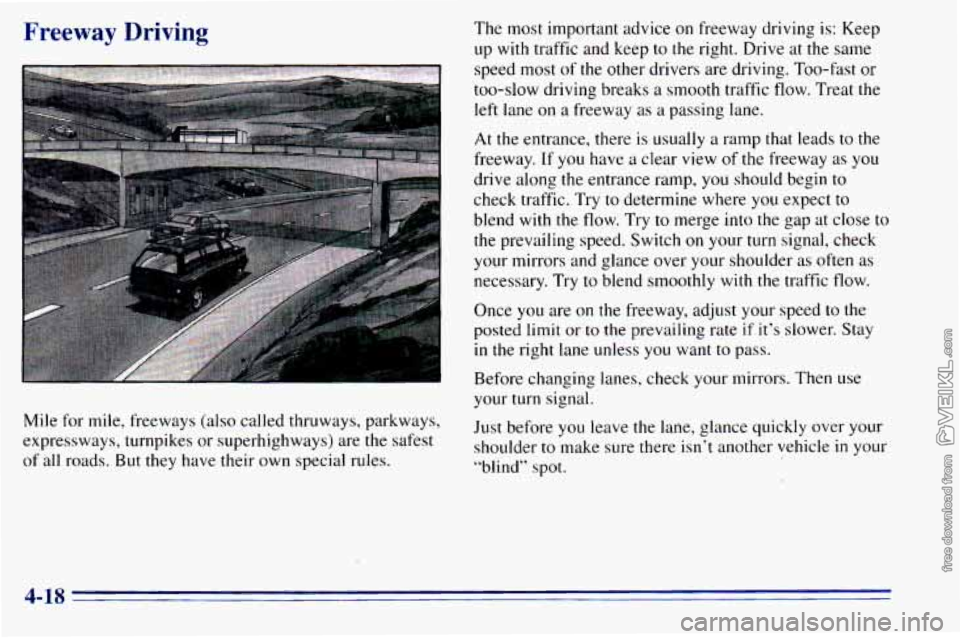
Freeway Driving
Mile for mile, freeways (also called thruways, parkways,
expressways, turnpikes or superhighways) are the safest
of all roads.
But they have their own special rules. The
most important advice on freeway driving is: Keep
up with traffic and keep to
the right. Drive at the same
speed most of the other drivers are driving. Too-fast or
too-slow driving breaks
a smooth traffic flow. Treat the
left lane
on a freeway as a passing lane.
At the entrance, there
is usually a ramp that leads to the
freeway.
If you have a clear view of the freeway as you
drive along the entrance ramp, you should begin to
check traffic. Try to determine where
you expect to
blend with
the flow. Try to merge into the gap at close to
the prevailing speed. Switch on your turn signal, check
your mirrors and glance over your shoulder
as often as
necessary. Try to blend smoothly with the traffic flow.
Once you are on the freeway, adjust your speed to the
posted
limit or to the prevailing rate if it's slower. Stay
in the right lane unless you want to pass.
Before changing lanes, check your mirrors. Then use your turn signal.
Just before you leave the lane, glance quickly over your
shoulder to make sure there isn't another vehicle
in your
"blind" spot.
4-18
Page 174 of 372
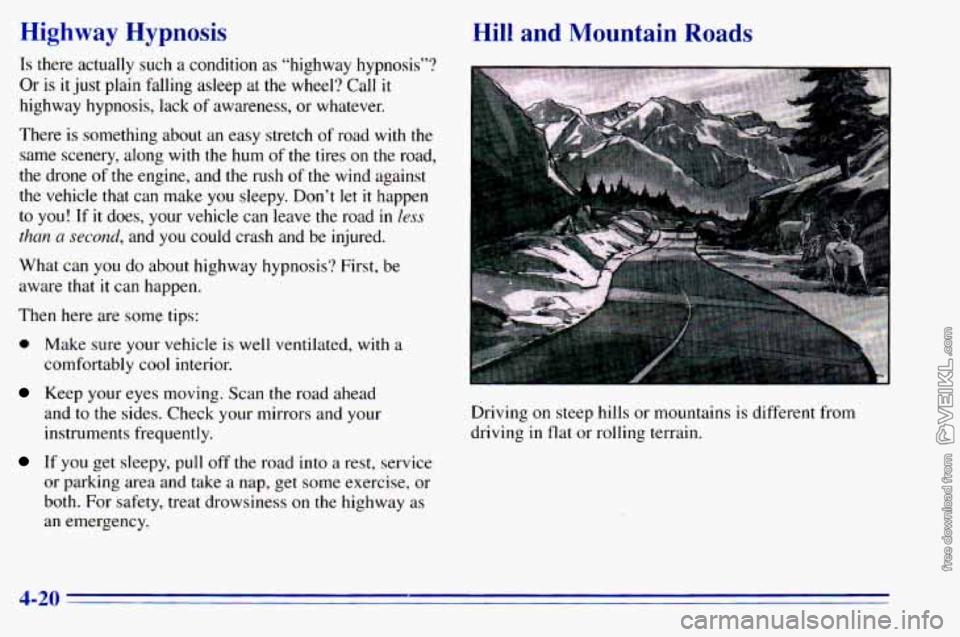
Highway Hypnosis
Is there actually such a condition as “highway hypnosis”?
Or
is it just plain falling asleep at the wheel? Call it
highway hypnosis, lack of awareness, or whatever.
There is something about an easy stretch of road with
the
same scenery, along with the hum of the tires on the road,
the drone
of the engine, and the rush of the wind against
the vehicle that can make
you sleepy. Don’t let it happen
to you! If it does, your vehicle can leave the road in Zess
than a secund, and you could crash and be injured.
What
can you do about highway hypnosis? First, be
aware
that it can happen.
Then here are
some tips:
0 Make sure your vehicle is well ventilated, with a
comfortably cool interior.
Hill and Mountain Roads
Keep your eyes moving. Scan the road ahead
and to the sides. Check your mirrors and your
instruments frequently. Driving on
steep hills or mountains is different from
driving
in flat or rolling terrain.
If you get sleepy, pull off the road into a rest, service
or parking area and take a nap, get some exercise, or
both. For safety, treat drowsiness
on the highway as
an emergency.
4-20